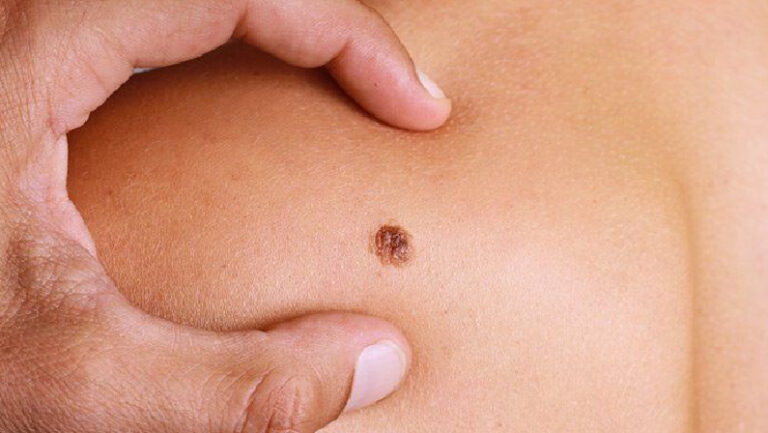Houston Melanoma Specialists
Best Melanoma Specialist In Texas

Embark on a journey of exceptional melanoma treatment in Texas at Skin Cancer Specialists, where having the best melanoma specialist is pivotal in ensuring unparalleled treatment outcomes. Dr. Tarek M. Fakhouri, a board-certified dermatologist and fellowship-trained Mohs surgeon, leads our practice, bringing extensive expertise to the forefront.
Melanoma, a complex form of skin cancer, demands the highest level of specialized care. At Skin Cancer Specialists, our approach to melanoma treatment combines precision, innovation, and personalized care. As the best melanoma specialist in Texas, Dr. Fakhouri’s advanced expertise in Mohs surgery and various cosmetic and laser procedures set the stage for a meticulous and effective treatment process.
The expertise of Dr. Fakhouri, who served as the Director of Mohs Surgery at Wayne State University’s Department of Dermatology, adds a distinctive layer to our practice. Having successfully performed and assisted with thousands of Mohs micrographic surgeries, he brings a wealth of experience to the forefront, ensuring patients receive the best care available.
Choose Skin Cancer Specialists for a comprehensive and personalized approach to melanoma treatment in Texas. Our commitment to excellence, under the leadership of Dr. Tarek M. Fakhouri, redefines standards in melanoma care, assuring patients of the finest specialized care available.
Understanding Melanoma
What is melanoma? It is a deadly skin cancer that can develop anywhere in the body. It’s the most common form of skin cancer, and it’s especially common in people who are over age 30.
Melanoma is often treated with surgery, radiation therapy, and chemotherapy. If it’s caught early, melanoma can often be cured. However, if melanoma is not detected or treated early, it can spread to other parts of the body and cause death. Melanoma is not just a problem for young people; anyone can get melanoma.

Types Of Melanoma
Melanoma can be classified into two categories- main types and rare types. The two categories are based on the level of risk the person has for developing the cancer.
Main Types Of Melanoma

Superficial Spreading Melanoma
The most common type of melanoma, this form affects the top layer of skin and spreads in a manner similar to that of a scab when you get a cut. It’s more likely to occur in men than women, and people with light skin are more susceptible than those with darker complexions. This type is also more likely to occur on areas exposed to sunlight, such as your hands, feet, face and scalp.
Nodular Melanoma
Nodular melanoma is the least common type of melanoma, but it is also the most dangerous. It tends to occur on the head, neck, and trunk in older people. These tumors are usually larger than 0.5 inches (1 cm) in size, but they can be smaller.
Nodular melanoma tumors have an irregular border and may have a raised appearance or be flat with an even surface coloration. The color may vary from pink to dark brown to black depending on how much pigment is present in your skin and where you live (more sun exposure increases the chances of developing more pigmented lesions).


Acral Lentiginous Melanoma
Acral lentiginous melanoma is a type of melanoma that can occur anywhere on the body and may be more likely to spread than other types of melanoma. Acral lentiginous melanoma most often appears on the palms or soles, but it can also appear elsewhere on the body.
Acral lentiginous melanomas are more common in people with darker skin, such as those of African American, Hispanic/Latino or Asian descent. They are also found more often in older adults who have spent a lot of time in the sun over the years (for example, farmers).
Lentigo Maligna Melanoma
Lentigo maligna melanoma is the most common type of melanoma. It starts in flat, or lentiginous, spots on the skin that are sometimes called freckles.
The cells in lentigo maligna do not grow as quickly as those in other types of melanoma. The cancer spreads slowly and tends to stay within its first layer of skin. This means it is less likely to spread to other parts of your body than other kinds of melanomas are.* However, if left untreated, it still can be deadly.*

Rare Types of Melanoma
There are also rare types of melanoma that occur very rarely, such as:

Spitzoid Melanoma
Spitzoid melanoma is a type of melanoma that looks like a mole. It can be hard to diagnose because it looks like a normal mole at first, but over time the cells in your skin will change and you may develop symptoms.
Spitzoid melanoma usually starts on the head, neck, and trunk (the parts of your body where you have skin). This kind of cancer is more common in men than women.
Nevoid Melanoma
Nevoid melanoma is a rare form of melanoma that’s more common in women, people with light skin, and those with a family history of the disease. It usually develops in adults over the age of 50 and is most often found in the head and neck area.


Desmoplastic Melanoma
Desmoplastic melanoma is a rare type of melanoma that starts in the deeper layers of skin, rather than in the upper layers. It most often affects fair-skinned people, particularly those with blue eyes.
The signs and symptoms of desmoplastic melanoma can include:
- A firm or hard lump under your skin that feels like a bruise or growth.
- A lump around an existing mole (a spot where a tanning cell has grown out of control).
- Changes to an existing mole, such as itchy skin around the spot and bleeding from it after you pick at it (this is called “excisional biopsy”).
If you have any skin changes that worry you, see your doctor for advice straight away so they can be properly checked out by an expert.
Concern about a mole? Visit Skin Cancer Specialists to learn more about melanoma.
Melanoma Causes
Melanoma appears when cells in the skin that produce melanin (a natural pigment) grow uncontrollably.
Many factors can cause melanoma, including:
- Exposure to the sun
- Genetics
- Skin cancer treatments such as radiation or surgery
Early diagnosis and treatment is essential for successful outcomes

Melanoma Symptoms

Here are some of the most common melanoma symptoms to watch for:
- A change in the appearance of the skin, such as a new mole, which may be darker than your usual skin color or have a different shape or size.
- A new lump or swelling on the skin that doesn’t go away.
- Difficulty breathing due to an enlarged lung or airway obstruction from the tumor.
- Nausea and vomiting due to the spread of cancer cells to other parts of the body.
Melanoma Diagnosis
Melanoma appears when cells in the skin that produce melanin (a natural pigment) grow uncontrollably.
Melanoma is a potentially deadly skin cancer that can be difficult to diagnose. It’s most commonly diagnosed by a doctor when an existing skin lesion starts growing or changing in shape, but it can also be spotted during skin checks for other types of cancer. There are several ways to diagnosis melanoma:
- Self-examination
- Using a mole checker
- Examining the ABCDEs
- (Asymmetry, Border irregularity, Colour change, Diameter greater than 1 cm)
- Hving a skin biopsy don

Concerned about a mole? Visit Skin Cancer Specialists to learn more about melanoma.
How Our Melanoma Treatments Work
The best way to treat melanoma depends on the stage of the cancer. Below are some of the treatment options we offer at the Skin Cancer Specialists led by Dr. Fakhouri.

Surgery
Surgery is the most common treatment for melanoma. It’s done to remove all or part of a tumor and surrounding tissue, in order to keep it from spreading. The surgeon will determine if you need surgery based on your specific condition and location of the tumor.
Surgery can be performed in an outpatient setting or as an inpatient surgery depending on the type of procedure being performed, your medical history and other factors.
Surgery is more effective when it’s done early because cells are less likely to spread throughout your body at this stage than later when they’re more developed.
Immunotherapy
There are two types of immunotherapy:
Ongoing (Maintenance) Therapy
This type of treatment is given after surgery to keep the cancer from coming back in future years. It’s often used for people with advanced melanoma who have a higher risk for recurrence because their tumors are less likely to respond well to chemotherapy or radiation therapy.


Temporarily Stopping (Pulsing) Your Immune System
This type of treatment is given after surgery to keep the cancer from coming back in future years. It’s often used for people with advanced melanoma who have a higher risk for recurrence because their tumors are less likely to respond well to chemotherapy or radiation therapy.
Targeted Therapy
Targeted therapy is a type of treatment that works by finding and targeting specific genes, proteins or other molecules that are involved in cancer cells. Targeted therapy works by blocking the action of specific genes, proteins or other molecules that are needed for cancer cells to grow and divide. By blocking these genes, proteins or molecules it’s possible to stop cancer cells from growing and spreading around the body.


Radiation Therapy
Radiation therapy is a treatment that uses high-energy rays to destroy cancer cells. Radiation therapy is used to treat melanoma that has spread to the lymph nodes, as well as for certain types of advanced melanoma that have spread to other parts of the body. The doctor will determine how much radiation you need and where it should be aimed.
Chemotherapy
Chemotherapy is a type of medicine that uses chemicals to kill cancer cells. It does this by stopping the division of the cells or by stopping new blood vessels from forming. The way chemotherapy works depends on the type you receive and how it’s given.
Chemotherapy can be taken in many ways, including orally (by mouth) or intravenously (into a vein). Some forms can also be applied directly to your skin. Your healthcare team will choose which method is best for you based on where your melanoma is located and its stage.

Benefits Of Our Melanoma Treatment
Experts at Skin Cancer Specialists offer a variety of melanoma treatments to help patients achieve the best possible outcome. Our team of experts can help you decide on the best course of action for your individual situation, based on your diagnosis and treatment goals

Some of the benefits of our melanoma treatment program include:
- Early detection and treatment is key to preventing melanoma from becoming more advanced and potentially deadly. At Skin Cancer Specialists, we offer a comprehensive approach to melanoma care that includes regular screenings and early detection testing.
- Our highly experienced team of doctors is committed to providing the best possible care for our patients. We have years of experience in treating skin cancers, and our knowledge is backed by rigorous research.
Our treatment options are diverse and range from traditional surgery to cutting-edge technology like robotic surgery and radiation therapy
Bleeding moles? Skin Cancer Specialists will give the immediate medical attention you need.
Our Melanoma Treatments Cost
Our melanoma treatments cost vary depending on the type of treatment and where it is performed. Contact Skin Cancer Specialists for more information.
Why Choose Skin Cancer Specialists For Your Melanoma Treatment
At Skin Cancer Specialists, you will know that you are well-taken care of from consultation to post-treatment.

Our Experience With Melanoma Patients Is Extensive
Our experience with melanoma patients is extensive. We have treated thousands of melanoma patients at our practice and are well-versed in the disease, its treatment options and the best ways to manage your health throughout your journey.

We're Proud Of Our Research
At Skin Cancer Specialists, we’re proud of our research and our people. We’ve been a leader in the field for over 20 years, with a long history of success when it comes to treating melanoma. Our doctors are committed to finding new ways for people with this serious form of skin cancer to live longer, happier lives.

We’re Proud Of Our People
They’re here to help you every step of the way as we work together on your treatment plan. They can answer any questions that you may have about your diagnosis or how we’ll approach treating it, so feel free to ask them anything! They’ll be happy to help however they can.

Board Certification Matters
Board certification means that a doctor has gone through rigorous training and testing to demonstrate their expertise in their field. The board certifying body will ensure that the doctor has kept up with current research, that…
they have knowledge of all relevant medical technologies and treatments, and that they are familiar with the latest treatment options for melanoma patients. This ensures that you have access to state-of-the-art treatment options from doctors who aren’t just qualified to treat your condition – they’re experts at it!
Not all doctors are equal, and we’re proud to be the best in the business.
FAQ’s
How dangerous is melanoma?
Melanoma is the sixth most common cancer in the U.S. and the most dangerous form of skin cancer. Although it’s highly curable at an early stage, untreated melanoma spreads to lymph nodes and internal organs. Once it metastasizes, melanoma is hard to treat and often deadly.
Melanoma risk factors
There are many melanoma risk factors, but only some people are truly at risk for developing this disease. Here are a few of the more common melanoma risk factors:
- Genetics: Some people inherit a gene that makes them more likely to develop melanoma.
- Sun exposure: Spending time in the sun increases your own risk of developing melanoma, and sun exposure can also increase your risk of getting melanoma in someone else.
- Age: Melanoma is most common in people over 50 years old.
- Skin type: People with fair skin are at a higher risk than those with darker skin for developing melanoma, because fair skin is less able to protect itself from the sun’s harmful rays.
- Family history: If one or both parents have had melanoma, you’re likely to have a higher risk as well.
Melanoma prevention
The most effective way to prevent melanoma is to avoid the sun’s ultraviolet (UV) radiation. Sunscreen with a broad-spectrum SPF of 30 or higher is the best way to protect your skin from UV radiation and reduce your risk of developing melanoma.
Other recommended practices for melanoma prevention include wearing clothing that covers your skin, using a shade protection filter on windows and doors, and avoiding indoor tanning.


